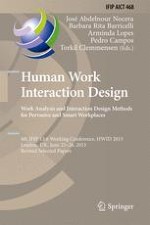2015 | OriginalPaper | Chapter
From Transactions to Relationships: Making Sense of User-Centered Perspectives in Large Technology-Intensive Companies
Authors : Petra Björndal, Elina Eriksson, Henrik Artman
Published in: Human Work Interaction Design. Work Analysis and Interaction Design Methods for Pervasive and Smart Workplaces
Publisher: Springer International Publishing
Activate our intelligent search to find suitable subject content or patents.
Select sections of text to find matching patents with Artificial Intelligence. powered by
Select sections of text to find additional relevant content using AI-assisted search. powered by
